14 Oct The Cape Wrath Trail – what went wrong
It’s been quite a while since I last wrote a blog post. Back in June I posted a film about a Lake District adventure. Right now I’m planning my next (mini) Lakeland adventure: a two-day hike across 14 eastern Wainwrights in November. In a sense, this is my first step towards a re-attack on the Cape Wrath Trail, the hike that failed so horribly for me back in April.
Shortly after I returned from Scotland, Trail magazine commissioned me to write about mountain safety. I was to reflect on my own accident, and interview mountain safety experts on the psychological and practical factors that can lead even the most experienced hikers and mountaineers to grief. The short story I told in Trail’s September issue is simple: I hurt my left knee after falling on snow below the Forcan Ridge, having decided – madly – to try to complete two of my planned days in one. I still cringe to recall how sensible this seemed to me at the time.
Six months on, I feel ready to start preparing myself for the difficulties I know I will face next time, and part of that preparation is a thorough review of what went wrong. I’ve been thinking deeply about my experiences, and I finally feel ready to write about the best – and worst – hike of my life. So here, for the first time, is the full story behind my embarrassing misadventure – and how I’m already working to remedy it.
You can see my original Cape Wrath Trail route card here, including links to my OS Maps routes. Read on and watch my short film about the walk before you decide if it’s a plan to be borrowed…
A’ Chuil to Barisdale
View my route on Garmin Connect.
The days before the accident were tough. (EVERY day in Knoydart is tough.) As I entered the Rough Bounds I realised my 15.4kg pack was too heavy (you can see my pack weight on LighterPack – a fantastic resource). Wary of growing too tired too quickly, I abandoned my planned route to the spectacularly isolated Kinbreack bothy; instead, I fell in with three fellow hikers and headed for A’ Chuil bothy. We found the bothy attended by a 71-year-old MBA volunteer (Bob, who had stoked a roaring wood fire in the cottage’s stone hearth), a group of German geology students and their husky, Aisa. We shared whisky and mountain tales, huddled around the fireplace.
As night deepened, Bob and I stood in front of the cottage beneath a coal-black sky fretted with pinprick stars and the faint arc of the Milky Way. On the opposite side of the glen we could see torches shining high on Sgurr Còs na Breachd-Iaoidh – carried by hardier souls, presumably, camping on top of the Corbett. I felt happy to have the bothy’s warmth.
The next day dawned dreich. The clear skies had filled with dirty grey clouds, and the glen’s shades of russet and green had been watered down into a solid muddy grey-brown. Having left Bob with some of my nonessential kit to post home, I strode out into the drizzle. I reached Lochan a’ Mhaim in good spirits, and paused to appreciate the gentle hiss of rainfall in the slate-grey water. A little further along, at Sourlies, a herd of deer thundered across the beach at the head of the sea loch.
Deep down, I know I should have rested overnight at Sourlies. My re-route via A’Chuil added another 9km to my planned route: 33km in total, a hell of a stretch even on relatively easy terrain. To add to the challenging distance, the only bridge across the notoriously treacherous River Carnach had been taken down for maintenance, imposing the need for a river crossing.
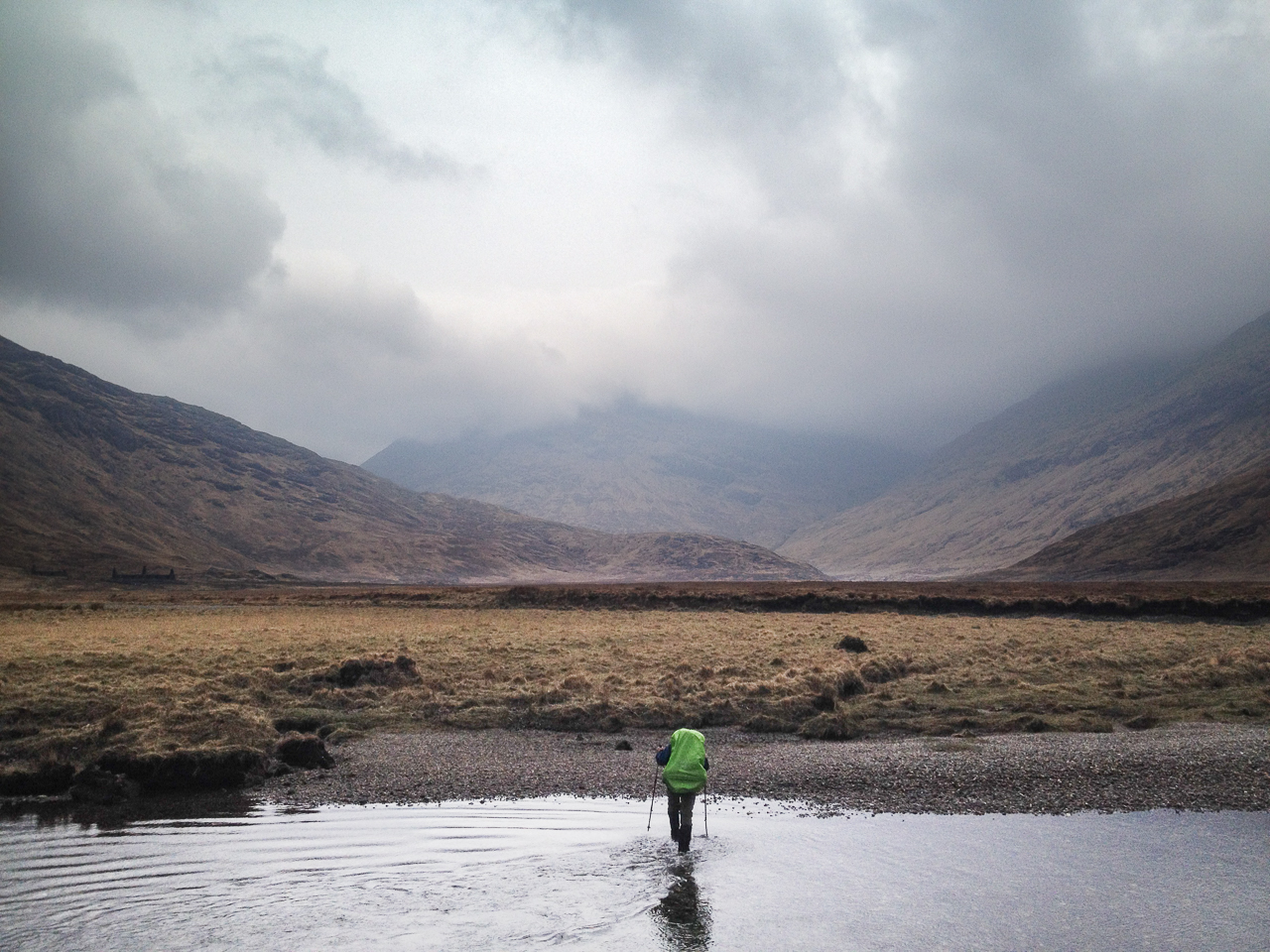
Still, my mood was buoyant and I felt strong. After resting at Sourlies I’d been caught up by the German team from A’ Chuil, two of whom agreed to see me safely across the river. As it happened, the crossing was straightforward: the water was rushing just below knee-height, and was so clear I was able to see my footing with ease. I pressed across carefully, using my trekking poles to help me brace against the fast water.
Beyond the river lay another 16km of almost entirely unmarked terrain. The ground was boggy and slick, and at Carn Mòr I had a shattering climb to join my original planned route. I reached Barisdale bothy well after nightfall, grateful for the bed space and a chance to demolish my pack rations.
Barisdale to Kinloch Hourn
View my route on Garmin Connect.
I’m a cautious planner. When I plotted my Cape Wrath Trail route I made ample allowance for the challenging terrain and my own likely exhaustion, following advice from my Cicero guide and the ever-helpful Alex Roddie (whose bothy book entries at Corryhully, A’ Chuil and Sourlies did a lot to boost my spirits). The previous day’s exertion was all the evidence I could need for Knoydart’s hostility, and for the need to be conservative in my approach to the next stage.
Had I listened to my own caution, I’d have stuck with my plan for the day: an 11km hike to Kinloch Hourn. There I was to camp for the night before tackling the serious challenge of a 19km hike to Shiel Bridge, crossing over the Cape Wrath Trail’s highest point just below the Forcan Ridge. But here’s where things went badly wrong.
I reached Kinloch Hourn by lunchtime, in high spirits. It had been a beautiful walk, high above the twinkling Loch Hourn. Kinloch Hourn itself was silent and lonely. As I walked between the quiet houses scattered around the valley floor, the sense of isolation started to bear down on me. I started to wonder if I could bank a rest day by pressing on to Shiel Bridge.
As best as I can recall, my logic went like this: “Yesterday I managed to walk 33.5km, including a serious climb; if I press on to Shiel Bridge, I’ll be walking 3km short of yesterday’s distance; and if I manage to rest up for a day, I’ll be all the stronger for the next stage of the trail.”
Now I need only look at a map to realise that this particular train of thought was carrying me towards a derailment. In my keenness to make progress I ignored my pre-hike caution and paid no attention at all to the likely difficulties presented by a mountain climb on top of an already taxing day.
But I pressed on.
From Kinloch Hourn the path lofted high into the wild terrain of Kinlochourn Forest, leaving behind the mineral scent of the sea loch. Here I felt truly alone: the path stretched on into a landscape of intimidating bleakness, with only the light trickle of a track-side burn to relieve the deep and unfamiliar silence. The hills had robbed me of any sensory input beyond the sight of the tortured bogs and peaks, and the increasing scale of my own exhaustion.
Soon I reached the deep corrie between Mullach Gorm and Sgurr na Sgine, whose bare rocky tops glowered down at me as I pressed uphill. By now I was beyond tired – weary and demoralised.
But I pressed on.
I found myself high on the side of the corrie, on a precariously narrow ledge high above the valley floor.
But I pressed on.
And on.
The accident
At 700m, Bealach Coire Mhàlagain is the highest point on the Cape Wrath Trail. Although 2019 had been unseasonably mild, 700m is well above the snow line in April, and the bealach was almost in winter conditions. I paused to stab my trekking poles into the frozen lake at the high point, and slushy ice gushed out of the hole. Ahead of me I had to follow a long path clinging close to the edge of a steep drop – but the path had been buried under what was left of the winter’s snow.
I picked my way along the snow as carefully as I could, but by now I was tired and frustrated; every few steps I slipped just a little, and although I used my poles to test for voids in the snow eventually I missed one. My left foot suddenly disappeared below me; fearing a stumble towards the drop I jammed my poles into the snow and pushed my body weight back towards the hillside. A white-hot ball of pain erupted in my knee. My yell of pain reverberated around the corrie, sank into the snow and died, unheard.
What remained of my Cape Wrath Trail was an agonising descent from the mountain. I stumbled downhill to the Old Military Road, and hitch-hiked to my hostel at Ratagan. The following day – supposedly my rest day – I realised I couldn’t risk pushing further into remote terrain, and made the agonising decision to withdraw from the Trail.
My Cape Wrath Trail took me the better part of 8 months of planning and preparation. In it, I saw an opportunity to better my exhilarating hike along the Pennine Way, and to create new stories for myself about my own confidence and resilience. All of that – my hopes, my enthusiasm and my self-confidence – lay rotting in a snow hole, high on a hostile mountain.
What have I learned?
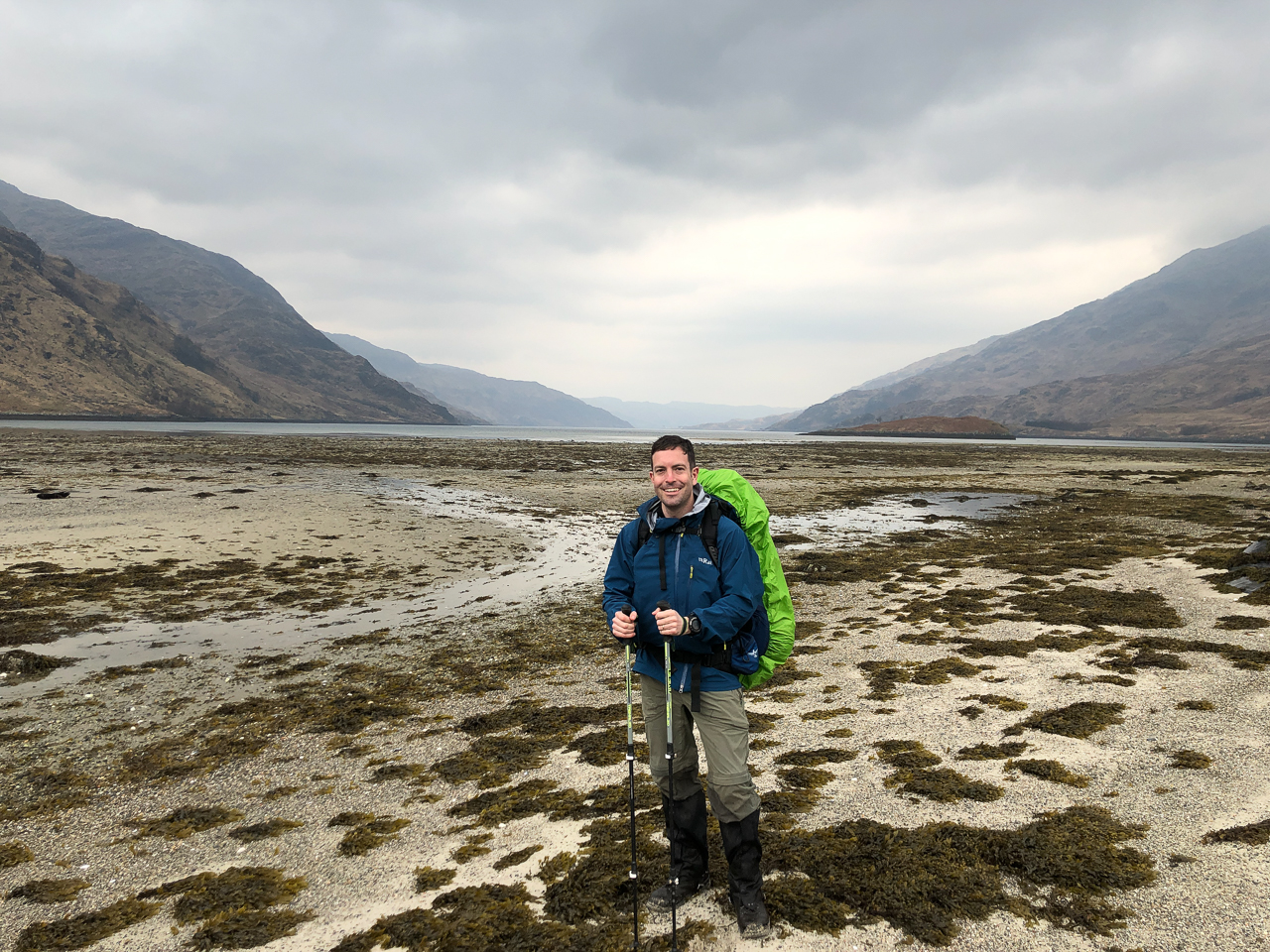
Disappointment and failure are bitter, and it took some time for me to start seriously reviewing what had led me to my accident. Looking back over my experience, I think I can offer four pieces of advice to the would-be Cape Wrath Trailblazer. Whether I’m to be trusted after making such an embarrassing misjudgement, I leave to you to decide.
- Common sense flees when weariness steps in. Obviously, I shouldn’t have attempted to walk two days’ routes in one – it feels absurd even to have to state it. I plan carefully for a reason – but all reason seemed to disappear when exhaustion gave way to weariness. Somehow the false promise of an extra day’s rest blinded me to what I was really doing: swapping an afternoon’s genuine rest for a climb into dangerous terrain at the end of a very long couple of days. I am astonished that I put myself in such a position, but when I felt weary, I couldn’t see that distant rest day for what it really was: a mirage shimmering on an impossibly distant horizon. My next attempt will be based on somewhat shorter days, making better use of bothies and wild camping – and I will do better to trust in my own pre-hike awareness of the difficulties I might face.
- Plans are great – but goals can be toxic. I stand by my planned route: the days were tough, but bearable, and the terrain wasn’t beyond my skill level (until I allowed myself to get too tired). But I had a time constraint imposed by leave from a full-time job: 18 days for the whole route. This left me no time for rest days, or to stop short if a day was especially tiring: every day was about reaching a goal, not simply about eating up as many klicks as I could safely manage. The Cape Wrath Trail does not offer hikers the luxury of certainty: flexibility is a critical part of the trailblazer’s mountain kit. Now I’m a freelance, I can (kind of) afford to allow myself time to complete the Trail in my own time, at a pace that suits the conditions and my own fitness.
- Pack light. Everyone who has ever attempted the Cape Wrath Trail says the same thing: strip your kit back to the essentials. I set off with a couple of kilos I really didn’t need, and was lucky to be able to leave them with a trusted bothy volunteer to post home (even though I wasn’t expecting to be at home to receive them!). I can’t say for sure if the dead weight added to the exhaustion that eventually laid me low – but it can’t have helped. Pack light. PACK LIGHT.
- Don’t be too hard on yourself. I only managed four days of the Cape Wrath Trail. I returned home feeling crushed and embarrassed – even ashamed. This is entirely unreasonable. My knee wasn’t hurt beyond repair, my enthusiasm for the mountains remains undimmed, and the risk of failure is what makes the Cape Wrath Trail – indeed, any long-distance hike – such an enticing challenge.
I lived and learned. I crossed Knoydart. I stood beneath the Milky Way, looking out over a dark and silent glen. I set foot on the Cape Wrath Trail. Even to start it is to participate in an incredible adventure.
And my adventure isn’t over yet.
Update, March 2020. Well, I had hoped to be back on the trail between March and April – but the coronavirus outbreak stalled my plans. Some of the comments below give good advice for anyone considering an attempt. Hopefully I’ll be striding back towards the hills a little later in 2020.


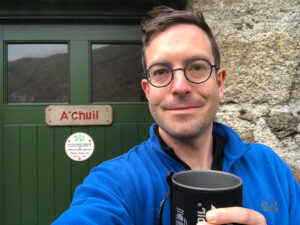
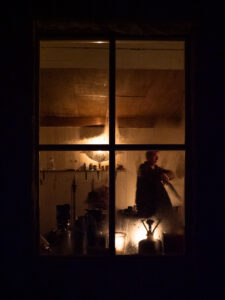
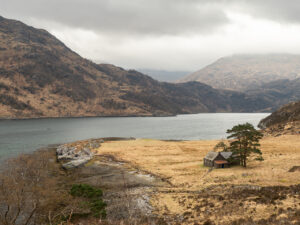
Ioanna
Posted at 08:11h, 15 OctoberThank you for this article. The skill of knowing when to quit, stop, or change plans is crucial, no matter the years of experience under our belt. We don’t hear enough stories about that, falling into the horrible belief that we must press on, never quit, leading to possibly dangerous situations. I wish there were more stories of sensibility, courage to quit, and lessons from mistakes in our community.
Andy Wasley
Posted at 13:18h, 15 OctoberThanks Ionna. There’s really no shame at all in deciding it’s unsafe to proceed, even though the immediate feeling of failure can be all-consuming. That’s still better than taking the risk of a mountain rescue callout – or worse – because of the desire to push on even when body and mind are saying “enough!”.
Robin Wallace
Posted at 19:10h, 15 OctoberAn enjoyable read and a timely reminder for myself who hopes to attempt it next Spring. Hope your knee has fully recovered.
Andy Wasley
Posted at 22:49h, 15 OctoberThanks Robin! Thankfully the injury wasn’t as serious as it felt at the time; after six weeks or so of rest I was back in the hills.
Peter O'Donnell
Posted at 17:20h, 21 OctoberNice article Andy. Do you always hike alone? It is easy to get a bit carried away when you only have to convince yourself of a change of plan! We have all done it. A 2nd opinion can sometimes stop us from making silly errors. Looking forward to reading more of your travels.
Andy Wasley
Posted at 21:15h, 27 OctoberHi Peter – I hope you’ll forgive the delayed response. I usually hike alone. I appreciate the solitude, and I think there are some experiences you simply cannot have unless you’re completely solitary: I remember, for example, wild-camping on Ickornshaw Moor on the Pennine Way, and spending a night listening to lapwings swooping above my tent, snipes diving and drumming, and the mournful call of a curlew. Hard to imagine having the presence of mind to enjoy all of that if I had a companion with me.
That said, April’s mishap reminds me that the Pennine Way was also helped by spending some time trekking with a fellow wayfarer over a storm-blown Knock Fell, and on the final marathon to Kirk Yetholm. I guess my misanthropy is softening…
Ken Maxwell
Posted at 14:39h, 24 OctoberHi Andy, I enjoyed your article, in part I guess because I just had a similar experience to your, as I backed off from the CWT at Kinlochourn at the back end of Sept after a fall.
A month has now past and I’m back in West London thinking about how and what I’ll do differently next time. Like you, I think that once you’ve been there you know there’ll be a next time.
I look forward to seeing you make it all the way.
Andy Wasley
Posted at 21:12h, 27 OctoberHi Ken – thank you for the kind words. I’m sorry to hear about your accident. Kinloch Hourn marks the penultimate stage of a really tough few days’ walking; I wouldn’t be surprised if it’s where most would-be trailblazers have to drop out. It’s good that you got back safely. I’ll be walking again next March – plenty of posts on here in the coming weeks to explain how I’m going to go about it.
Stuart Lunn
Posted at 14:55h, 28 MarchHi Andy I really enjoyed your account of the CWT. I particularly admired your honesty and integrity. The CWT is a tough trail in and of itself made more so if you dealt a bad hand by gales force winds and rain. I did the Scottish National trail in August 2018 which encompasses the CWT and then I did the CWT again in 2019.
Here are some thoughts:
There is a direct correlation between pack weight and giving up.
Based on evidence from Kinlochewe Post Office approx. 50% of people that attempt the trail give up there i.e. they don’t collect their advanced food parcels.
Gales Force winds and rain combine to exacerbate difficult terrain perhaps break stages down into smaller sections when this happens.
I walk alone out of choice I take a Personal locater Beacon and I also use a Garmin Inreach to allow a pre formatted message to be sent to my wife ; ‘saying I’m ok’ every day, the message contains a link to a map giving co-ordinates. The Inreach can be used where there is no phone signal.
Compeed is good
I did not use leather boots for the CWT or Scottish National trail I use cloth based boots\trail shoes. They dry out quicker IMHO
Will be doing the SNT again later this year (subject to corana etc)
Hope to see you on the CWT or even the Scottish National trail
best wishes
Andy Wasley
Posted at 16:21h, 28 MarchHi Stuart
Thank you so much for the kind words – we only succeed if we learn from mistakes, and I think it’s important to share those lessons. I had hoped to be on the trail again – right now, in fact, I should have been enjoying a rest day in Morvich – but coronavirus put paid to my plans. I’ll keep your points in mind when I set off again – hopefully this year…
Karl
Posted at 16:26h, 17 OctoberAndy.
I was 56 last August, North Berwick was my Childhood Harbour Town from the age of 5 – 10, this year I have completed the John Muir Walkway between Helensburgh and Dunbar, the West Highland Walkway between Glasgow (Just outside.) and Fort William (just outside.) without too many obstacles, I attempted and completed the accents of Mount Suilven, and Stac Pollaiddh near Lochinver, but I am told by experienced Hikers that this is a different kettle of fish.
OK this maybe so, but I run 3 Miles daily before Work, I am very quick and nimble, but the only problem I have with The 240 Mile 3 week Quest is all these tales (Fact’s.) About avoiding getting apslutlie soaking wet on some Occasions, and that this is impossible to avoid, is this true?
Surely there must be dry walkway alternatives?
I have researched a route that I shall take along with Compass, I have good Field Craft skills from time in the Army.
But I would appreciate it if You could send Me some data advice on how I can take on this challenge, and what extra equipment to take, i.e. Waders, gloves x3, waterproof tops & leggings x2
Regards.
Karl Staines.
P.S My Quest begins in August 2022.
Andy Wasley
Posted at 20:14h, 21 MarchHi there Karl
I apologise for having taken so long to respond. It sounds like you have quite an adventure ahead of you!
I’m sorry to say it’s all but impossible to guarantee you’ll have a dry Cape Wrath Trail; I’d rather stake money on saying you will almost certainly get wet from time to time. It’s all part of the journey.
The mountainous terrain is very demanding on core navigation skills and fitness, so do make sure you take time to prepare. Research your route carefully, and always make sure you have backup options in case you’re forced to divert by weather or injury. Usual advice on making sure someone knows where you should be applies, too; it’s a serious hike and needs serious planning.
I’m afraid views on kit differ widely. I tend to be quite conservative and carry perhaps more than I need. Others prefer to hike light. And so it goes for footwear (boots or trail shoes), sleeping system and so on. All I can suggest is that you take a look at as many sites about the CWT as you can before you set off, ask other trailblazers for their views, and choose the kit that suits your skills, fitness and appetite for comfort. Be sure not to underestimate Scotland’s weather, even in August. (And be braced for the midges!)
Cicerone’s trail guide is essential reading and has plenty of advice on planning and kit. And Alex Roddie’s wonderful book ‘The Farthest Shore’ will give you an insight to the conditions you will face en route. In a way, I feel rather fraudulent offering advice, since my own adventure was so short and the years since have seen me push the next attempt back again and again. I hope my own experience offers you at least some understanding of the awesome and memorable challenges ahead, the magnificent landscape and the cameraderie you’ll find en route. I wish you the very best of luck with what will be the hike of your life.
Andy
Rachel Clarke
Posted at 19:05h, 30 SeptemberHi there,
Thank you for your honesty.
I’ve been intending to do the CWT since just before COVID. With 4 weeks off work in April next year, I will be finally doing it. Hopefully in 15 days, on my own, like all my long walks. I like your spreadsheet. Puts my prompt cards to shame!
As I’m going in April, and having read your story, I’m adding an extra day to my walk. Meaning I can do the Forcan Ridge section after a good rest! Admittedly my pack is a little under 8kg with food and water, but I’m about twice your age. So your cautionary tale has been duly noted. Thank you again 😊
Andy Wasley
Posted at 15:29h, 07 OctoberHi there Rachel
It’s great to hear you’re planning on tackling the Cape Wrath Trail! I did finally manage to complete it recently (but haven’t yet found the time to blog about it). It is a truly incredible experience – and you’ll appreciate it all the more for taking it a bit slower. I ended up hiking over three weeks, allowing plenty of time to relax and enjoy the good bits – and to recover from the challenging bits!
If you want to avoid the Forcan Ridge, you can follow a line of pylons north-west over Bealach Aoidhdailean, and bank a night at Suardalan bothy en route to Shiel Bridge. That’s the route I took this time, and it’s a lot less severe than the ‘traditional’ route. Suardalan is a beautiful bothy, too, and the landscape around it is absolutely magnificent.
I met an 80-year-old hiking through Knoydart. Age is no barrier. As I learned in 2019, and again in September, the only barrier to success (apart from injury) is negativity. You sound ready for the challenge, and I’m rooting for you.
Good luck!
David
Posted at 00:58h, 15 JanuaryHi Andy
Great post. I had a similar sort of experience the first time I walked CWT ..got to Kinloch hours carrying too much realized it wouldn’t be fun so “bailed” to inverness posted stuff home skipped ahead to ullapool and finished from there then came back to complete the section in between another time. Have since done in full a couple more times and some stretches more. I agree Suardalan is beautifully located (went that way once for a change) but prefer the Forcan ridge for dramatic views. Well done on completing it its a great experience.
I do love the CWT especially knoydart and torridon, and long distance walking solo and have been over the Forcan ridge a few times now including in winter.. testing the ice over the river crossing wasnt my favourite part despite having poles and microspikes. Walking in from inverie is also a lovely and gentler way to get to kinloch hourn
In 30+ years walking the lake district and Scotland and other long distance walks I’ve always told people…being willing to stop or take longer or not complete a walk is a real sign of strength and intelligence, just like adjusting a pack or tying bootlaces not waiting.. We have all made mistakes (navigation and others) when tired. Nobody criticises athletes for pulling out of a race when injured instead of pressing on and injuring themselves. So well done – disappointment and failure (and words like “bailing” which I used but don’t like) are the wrong ones for learning and being wise
I agree impossible (or very lucky indeed) to avoid rain on CWT but it is possible to do without being soaked through. Good waterproof gear inc overtrousers, sealskin socks , good boots and Berghaus yeti gaiters (with the rubber Rands to pull over boots) have worked for me.. never been totally soaked but have avoided falling in rivers 😀
Last.. in the last year after getting down to ennerdale from windy gap in gale like winds (a bit tricky) I was ambling along and got blown off my feet and blown over onto my face hitting a rock..minor injuries but came as a shock….so knowing limits is something we all keep learning
Andy Wasley
Posted at 11:23h, 15 JanuaryHi there David – thank you so much for sharing your story and experience. I’ve just been re-reading my CWT journal, and your comments chime with what I found there. On any mountain hike, you can make it all about the summit, or all about the journey – so it goes with big trails. 2019 haunted me for a long time, but it blends into my CWT memories now as just part of the journey; a tough part, for sure, but time – on the trail and since – has helped me find much-needed kindness for myself. Hope you recovered well from your stumble in Ennerdale. Black Sail Hut might have made a good first aid stop!